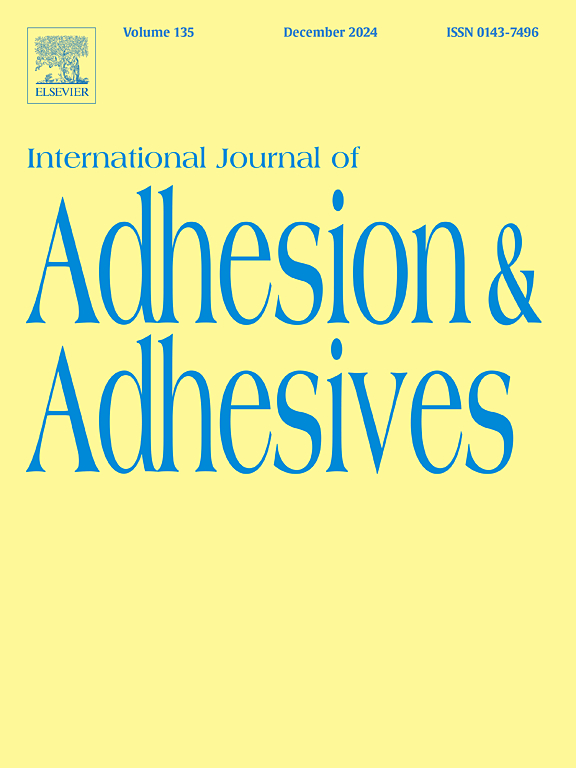Nano-reinforced adhesives: Effects of graphene, silica, and cellulose on mechanical properties of laminated wood materials
IF 3.5
3区 材料科学
Q2 ENGINEERING, CHEMICAL
International Journal of Adhesion and Adhesives
Pub Date : 2025-04-29
DOI:10.1016/j.ijadhadh.2025.104044
引用次数: 0
Abstract
This study investigated the effects of graphene, silica, and cellulose nanoparticles on the mechanical properties of laminated wood specimens using polyvinyl acetate (PVAc), urea-formaldehyde (UF), and epoxy (EPX) adhesives. Poplar (Populus nigra) and beech (Fagus sylvatica) veneers (4 mm thick) were bonded using adhesives enhanced with varying concentrations of nanoparticles: graphene (0.25 % and 0.50 %), silica (1 % and 2 %), and cellulose (1 % and 2 %). The laminated wood specimens were tested for modulus of elasticity (MOE), modulus of rupture (MOR), compressive strength (CS) and bonding strength (BS). The results showed that the EPX yielded the highest mechanical strength, followed by UF, while PVAc exhibited the lowest. The addition of all nanoparticles improved performance compared to the base adhesives. Graphene additions significantly improved MOE, MOR, and CS, while cellulose and silica primarily enhanced BS strength. Generally, increasing nanoparticle concentration enhanced mechanical properties, with the exception of BS, which decreased with higher silica concentration. These results demonstrate the potential for tailoring laminated wood properties by selecting specific nanoparticle types and concentrations, offering opportunities for optimized and potentially more sustainable material utilization across diverse applications, from furniture to structural components.
纳米增强胶粘剂:石墨烯、二氧化硅和纤维素对复合木材材料机械性能的影响
本研究研究了石墨烯、二氧化硅和纤维素纳米颗粒对聚氯乙烯(PVAc)、脲醛(UF)和环氧树脂(EPX)胶粘剂复合木材样品力学性能的影响。杨树(Populus nigra)和山毛榉(Fagus sylvatica)饰面(4毫米厚)使用不同浓度纳米颗粒增强的粘合剂粘合:石墨烯(0.25%和0.50%),二氧化硅(1%和2%)和纤维素(1%和2%)。测试了复合木材试件的弹性模量(MOE)、断裂模量(MOR)、抗压强度(CS)和粘结强度(BS)。结果表明,EPX的机械强度最高,UF次之,而PVAc的机械强度最低。与基础粘合剂相比,所有纳米颗粒的加入提高了性能。石墨烯的添加显著提高了MOE、MOR和CS,而纤维素和二氧化硅主要提高了BS强度。总的来说,随着纳米颗粒浓度的增加,纳米颗粒的力学性能增强,但BS的力学性能随着二氧化硅浓度的增加而降低。这些结果证明了通过选择特定的纳米颗粒类型和浓度来定制层压木材性能的潜力,为从家具到结构部件等不同应用的优化和潜在的更可持续的材料利用提供了机会。
本文章由计算机程序翻译,如有差异,请以英文原文为准。
求助全文
约1分钟内获得全文
求助全文
来源期刊

International Journal of Adhesion and Adhesives
工程技术-材料科学:综合
CiteScore
6.90
自引率
8.80%
发文量
200
审稿时长
8.3 months
期刊介绍:
The International Journal of Adhesion and Adhesives draws together the many aspects of the science and technology of adhesive materials, from fundamental research and development work to industrial applications. Subject areas covered include: interfacial interactions, surface chemistry, methods of testing, accumulation of test data on physical and mechanical properties, environmental effects, new adhesive materials, sealants, design of bonded joints, and manufacturing technology.
 求助内容:
求助内容: 应助结果提醒方式:
应助结果提醒方式:


